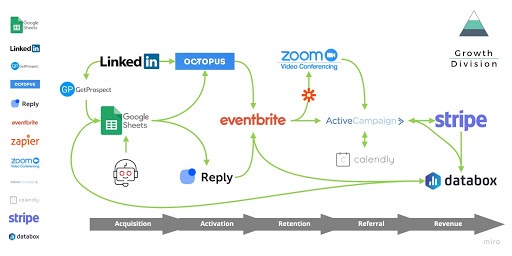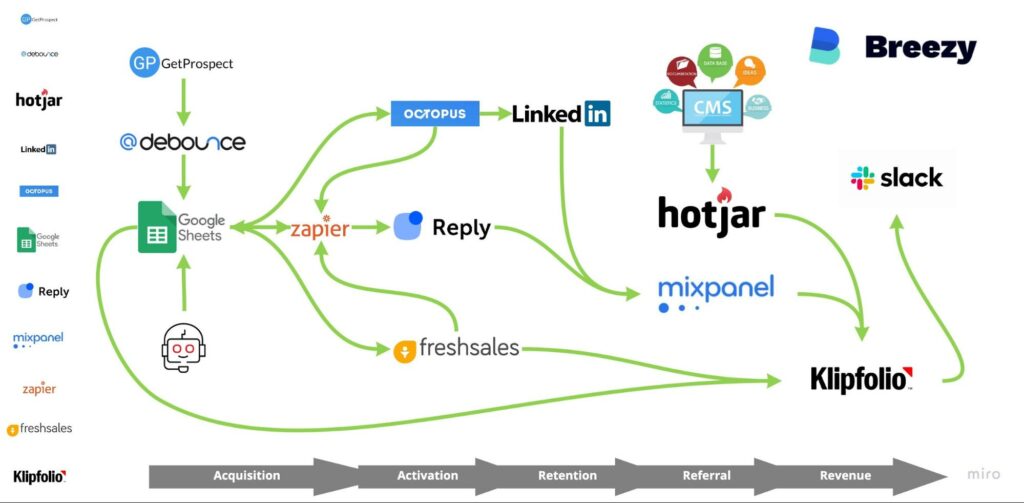Examples Of Martech Stacks: Making Marketing More Efficient

A martech stack is a suite of interconnected tools to help your business achieve more effective, more efficient and more measurable growth. It should be cover every phase of your sales and marketing funnel – acquisition, activation, retention, referral, revenue – and make life easier for your team. We’ve written an in-depth definition of what a martech stack is here and we’ve even put together a guide for how to build your own b2b martech stack, because we’re nice like that.
The benefits of a martech stack are:
- More effective marketing operations – by capturing higher quality data and making it easily accessible, your martech stack can help you make better channel spend decisions and reach your customers with more effective messages.
- More efficient marketing operations – a good martech stack should allow you to do more with less. You will waste less time following false trails and spend fewer hours on data administration.
- Centralised, de-siloed data. With a properly functioning martech stack you should have a smooth, efficient flow of data between systems. Data should be an asset, not a burden, and that’s what a good martech stack should help with.
Examples of martech stacks
It’s all very well talking about integrated systems and data flow, but sometimes that can be hard to picture.
As a growth marketing agency, Growth Division has helped countless clients build or refine their martech stacks. Along with setting the strategy, it’s often a core part of our service before live marketing begins.
We’ve therefore got a lot of good examples of best practice for building a martech stack.
Example 1: Marketing Funnel Automation Stack For Breezy
Working together with Mixpanel (a fantastic tool that we have used with great success over and over with our clients) we assembled a marketing automation stack for Breezy, a B2B partnership discovery engine.
First off, let’s discuss what Breezy wanted: marketing funnel automation. They wanted to automate the process of encouraging customers all the way through the marketing funnel, maximising conversion rates at each stage and therefore maximising the effectiveness of their marketing. These customers were to be nurtured from a waitlist for a beta launch, all the way through a product onboarding process.
The idea was that with more of this work automated, more resource would be freed up to focus elsewhere.
We helped them define their stack, then chose tools to work at each stage of the marketing funnel as you can see in the diagram below:

- GetProspect – a lead scraping tool, for filling the top of the funnel.
- DeBounce – for verifying the quality of the outreach data
- Zapier – an automated email outreach system
- Freshsales – a powerful CRM that doesn’t come at anywhere near the same price point as Hubspot. The plan Breezy needed was just £12/m.
- Hotjar – a tool for monitoring and measuring user behaviour on Breezy’s website to optimise conversion rates
- Mixpanel – an incredibly powerful product analytics programme. Growth Division is a Mixpanel certified partner and we use it all the time.
- Klipfolio – A reporting and analytics tool we used to view the flow of customers down the marketing funnel.
Example 2: Event Marketing Automation Stack
Our Growth Division Masterclasses were a series of events that were a huge success for our agency. To manage these events, we built an event marketing automation stack which we have since adapted and rolled out for several clients.
The purpose of this stack was to increase ‘bums on seats’ through lead generation and nurturing, and then maximise value with excellent post-event comms.
Once again, the stack was designed to work for every part of the marketing funnel from acquisition to revenue as you can see below:

Let’s run through some of these tools:
- GetProspect – for lead scraping. It has integrates fantastically with LinkedIn Sales Navigator, and it can work with a simple browser plugin. Fantastic for generating high quality lists of prospects.
- Google Sheets – Google Sheets is at the core of almost all our martech stacks. We use it as a centralised lead data hub. We’ve built a template for this purpose which we’d be happy to share with you if you get in touch.
- Octopus – a LinkedIn outreach automation tool. Once you’ve got your customer profiles created and lead data assembled, it’s time to reach out to them with Octopus.
- Eventbrite – an event management tool. There’s no better tool for the management and organisation of events in our opinion, and it integrates quite nicely with several major CRMs.
- ActiveCampaign – our CRM of choice for this stack. You can segment the data in your CRM by event attendance and build nurturing campaigns accordingly.
We’ve written a more in-depth explanation of this event marketing automation stack here.
Example 3: Startups.com Martech Stack
We’ve had a long association with startups.com and we were delighted to help them build a martech stack to make their acquisition and nurturing programme more efficient and effective.
Startups.com work with the following main channels:
- Affiliate marketing
- Paid social
- Paid search
- Viral marketing
- Organic social
The martech stack we built ensures these channels work together and share data smoothly:

Here’s a rundown of the tools we used:
- PartnerStack – an affiliate partnership management tool. It has a marketplace of partners who can sign up to your partner program. We use it in this case to enable startup communities and other partners to re-sell startups.com memberships to their networks and earn commission. PartnerStack integrates nicely with HubSpot, the CRM we are using in this stack.
- Hootsuite – an organic social management tool for scheduling posts and engaging with followers. It is integrated into databox, our analytics and reporting tool in this stack.
- HubSpot – our CRM of choice here. It’s an unbelievably powerful tool and is the industry standard for a reason. All leads are fed into HubSpot, where the marketing automation takes over.
- Freshdesk – a customer service tool which integrates seamlessly with HubSpot, allowing you to see data across both platforms.
- Viral Loops – a referral and viral marketing tool which allows you to test viral marketing mechanics. It’s a simple out of the box tool that allows you to track and incentivise referrals, and constantly test new ways of doing so. It’s also got a native integration with HubSpot which makes things nice and easy.
We hope these examples have been helpful in illustrating the way we build martech stacks and the decisions we make when building them. Reach out if you’d like advice on your own martech stack – we’re pretty good at this by now!
Talk to a Growth Advisor
We create a clear, focused marketing strategy by combining our expertise with your knowledge of your business.
Related Posts

Marketing Funnel Automation Stack
MarTech Stack Diagram What is marketing funnel automation? You’ve probably heard of a marketing funnel. The conceptual idea of...

Martech Stacks (Marketing Technology Stack)
Expert guidance on integrating martech tools and building a growth marketing automation engine for your business

21 Martech Statistics That Show How Marketing Is Changing
It seems that every year we growth marketers claim our industry has changed forever. Well, we’re not just repeating...
